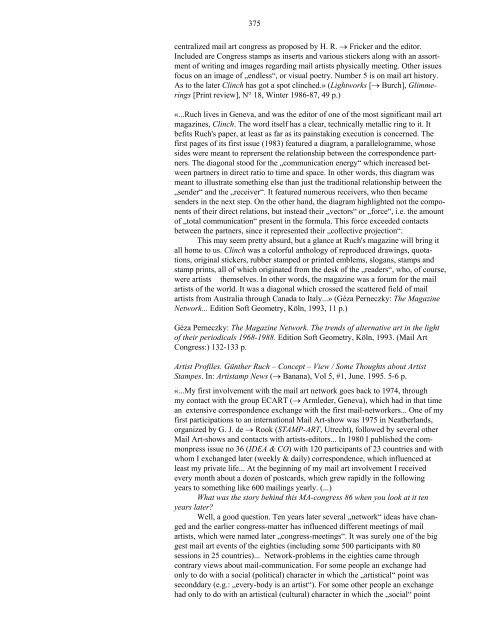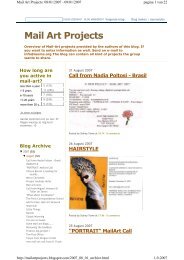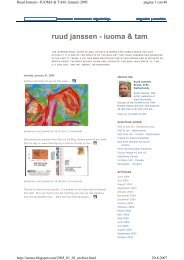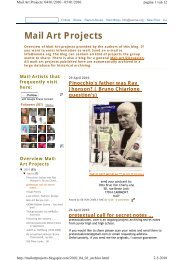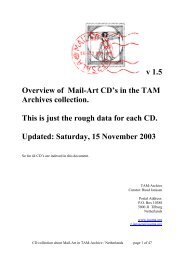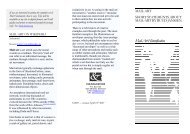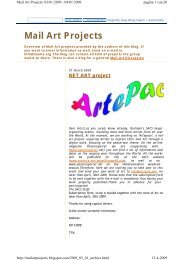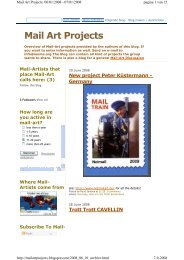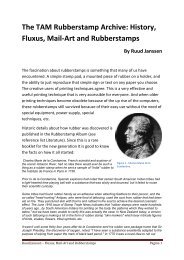Network Atlas by Geza Perneczky - Ruud Janssen
Network Atlas by Geza Perneczky - Ruud Janssen
Network Atlas by Geza Perneczky - Ruud Janssen
Create successful ePaper yourself
Turn your PDF publications into a flip-book with our unique Google optimized e-Paper software.
375centralized mail art congress as proposed <strong>by</strong> H. R. → Fricker and the editor.Included are Congress stamps as inserts and various stickers along with an assortmentof writing and images regarding mail artists physically meeting. Other issuesfocus on an image of „endless“, or visual poetry. Number 5 is on mail art history.As to the later Clinch has got a spot clinched.» (Lightworks [→ Burch], Glimmerings[Print review], N° 18, Winter 1986-87, 49 p.)«...Ruch lives in Geneva, and was the editor of one of the most significant mail artmagazines, Clinch. The word itself has a clear, technically metallic ring to it. Itbefits Ruch's paper, at least as far as its painstaking execution is concerned. Thefirst pages of its first issue (1983) featured a diagram, a parallelogramme, whosesides were meant to reprersent the relationship between the correspondence partners.The diagonal stood for the „communication energy“ which increased betweenpartners in direct ratio to time and space. In other words, this diagram wasmeant to illustrate something else than just the traditional relationship between the„sender“ and the „receiver“. It featured numerous receivers, who then becamesenders in the next step. On the other hand, the diagram highlighted not the componentsof their direct relations, but instead their „vectors“ or „force“, i.e. the amountof „total communication“ present in the formula. This force exceeded contactsbetween the partners, since it represented their „collective projection“.This may seem pretty absurd, but a glance at Ruch's magazine will bring itall home to us. Clinch was a colorful anthology of reproduced drawings, quotations,original stickers, rubber stamped or printed emblems, slogans, stamps andstamp prints, all of which originated from the desk of the „readers“, who, of course,were artists themselves. In other words, the magazine was a forum for the mailartists of the world. It was a diagonal which crossed the scattered field of mailartists from Australia through Canada to Italy...» (Géza <strong>Perneczky</strong>: The Magazine<strong>Network</strong>... Edition Soft Geometry, Köln, 1993, 11 p.)Géza <strong>Perneczky</strong>: The Magazine <strong>Network</strong>. The trends of alternative art in the lightof their periodicals 1968-1988. Edition Soft Geometry, Köln, 1993. (Mail ArtCongress:) 132-133 p.Artist Profiles. Günther Ruch – Concept – View / Some Thoughts about ArtistStampes. In: Artistamp News (→ Banana), Vol 5, #1, June. 1995. 5-6 p.«...My first involvement with the mail art network goes back to 1974, throughmy contact with the group ECART (→ Armleder, Geneva), which had in that timean extensive correspondence exchange with the first mail-networkers... One of myfirst participations to an international Mail Art-show was 1975 in Neatherlands,organized <strong>by</strong> G. J. de → Rook (STAMP-ART, Utrecht), followed <strong>by</strong> several otherMail Art-shows and contacts with artists-editors... In 1980 I published the commonpressissue no 36 (IDEA & CO) with 120 participants of 23 countries and withwhom I exchanged later (weekly & daily) correspondence, which influenced atleast my private life... At the beginning of my mail art involvement I receivedevery month about a dozen of postcards, which grew rapidly in the followingyears to something like 600 mailings yearly. (...)What was the story behind this MA-congress 86 when you look at it tenyears later?Well, a good question. Ten years later several „network“ ideas have changedand the earlier congress-matter has influenced different meetings of mailartists, which were named later „congress-meetings“. It was surely one of the biggest mail art events of the eighties (including some 500 participants with 80sessions in 25 countries)... <strong>Network</strong>-problems in the eighties came throughcontrary views about mail-communication. For some people an exchange hadonly to do with a social (political) character in which the „artistical“ point wasseconddary (e.g.: „every-body is an artist“). For some other people an exchangehad only to do with an artistical (cultural) character in which the „social“ point


